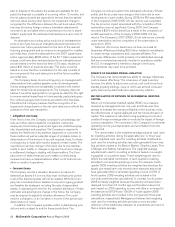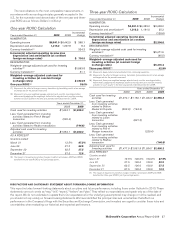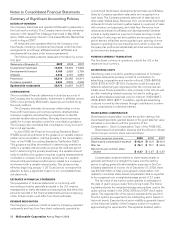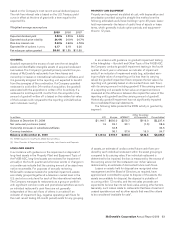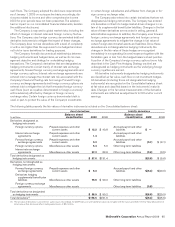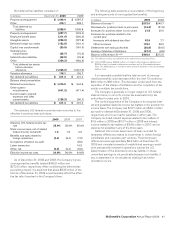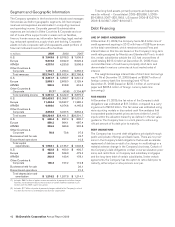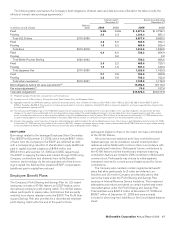McDonalds 2009 Annual Report Download - page 36
Download and view the complete annual report
Please find page 36 of the 2009 McDonalds annual report below. You can navigate through the pages in the report by either clicking on the pages listed below, or by using the keyword search tool below to find specific information within the annual report.
When the Company sells an existing business to a devel-
opmental licensee, the licensee purchases the business,
including the real estate, and uses his/her capital and local
knowledge to build the McDonald’s Brand and optimize sales and
profitability over the long term. The sale of the business includes
primarily land, buildings and improvements, and equipment, along
with the franchising and leasing rights under existing agree-
ments. Under the related developmental licensing arrangement,
the Company collects a royalty based on a percent of sales, as
well as initial fees, but does not have either any capital invested
in the business or any commitment to invest future capital.
An impairment charge is recognized for the difference
between the net book value of the business (including any for-
eign currency translation adjustments recorded in accumulated
other comprehensive income in shareholders’ equity) and the
estimated cash sales price, less costs of disposal.
The Company bases its accounting policy on management’s
determination that royalties payable under its developmental
license arrangements are substantially consistent with market
rates for similar license arrangements. Therefore, the Company
believes that the recognition of an impairment charge based on
the net cash sales price reflects the substance of the sale trans-
action.
FAIR VALUE MEASUREMENTS
In 2006, the FASB issued guidance in the Fair Value Measure-
ments and Disclosures Topic of the FASB ASC. This guidance
defines fair value, establishes a framework for measuring fair
value in accordance with generally accepted accounting princi-
ples, and expands disclosures about fair value measurements.
This guidance does not require any new fair value measure-
ments; rather, it applies to other accounting pronouncements that
require or permit fair value measurements. The provisions of the
guidance, as issued, were effective January 1, 2008. However, in
February 2008, the FASB deferred the effective date for one
year for certain non-financial assets and non-financial liabilities,
except those that are recognized or disclosed at fair value in the
financial statements on a recurring basis (i.e., at least annually).
The Company adopted the required provisions related to debt
and derivatives as of January 1, 2008 and adopted the remaining
required provisions for non-financial assets and liabilities as of
January 1, 2009. The effect of adoption was not significant in
either period.
Fair value is defined as the price that would be received to
sell an asset or paid to transfer a liability in the principal or most
advantageous market in an orderly transaction between market
participants on the measurement date. The guidance also estab-
lishes a three-level hierarchy, which requires an entity to
maximize the use of observable inputs and minimize the use of
unobservable inputs when measuring fair value.
The valuation hierarchy is based upon the transparency of
inputs to the valuation of an asset or liability on the measurement
date. The three levels are defined as follows:
• Level 1 – inputs to the valuation methodology are quoted
prices (unadjusted) for an identical asset or liability in an active
market.
• Level 2 – inputs to the valuation methodology include quoted
prices for a similar asset or liability in an active market or
model-derived valuations in which all significant inputs are
observable for substantially the full term of the asset or liability.
• Level 3 – inputs to the valuation methodology are
unobservable and significant to the fair value measurement of
the asset or liability.
Certain of the Company’s derivatives are valued using various
pricing models or discounted cash flow analyses that incorporate
observable market parameters, such as interest rate yield curves,
option volatilities and currency rates, classified as Level 2 within
the valuation hierarchy. Derivative valuations incorporate credit
risk adjustments that are necessary to reflect the probability of
default by the counterparty or the Company.
The following table presents financial assets and liabilities
measured at fair value on a recurring basis as of
December 31, 2009 by the valuation hierarchy as defined in the
fair value guidance:
In millions Level 1 Level 2 Level 3 Carrying
value
Cash equivalents $455.8 $455.8
Investments 115.7* 115.7
Derivative
receivables 79.6* $94.5 174.1
Total assets at
fair value $651.1 $94.5 $745.6
Derivative payables $ (7.0) $ (7.0)
Total liabilities
at fair value $ (7.0) $ (7.0)
* Includes long-term investments and derivatives that hedge market driven changes in
liabilities associated with the Company’s supplemental benefit plans.
• Non-financial assets and liabilities measured at fair
value on a nonrecurring basis
Certain assets and liabilities are measured at fair value on a
nonrecurring basis; that is, the assets and liabilities are not
measured at fair value on an ongoing basis but are subject to fair
value adjustments in certain circumstances (e.g., when there is
evidence of impairment). At December 31, 2009, no material fair
value adjustments or fair value measurements were required for
non-financial assets or liabilities.
• Certain financial assets and liabilities not measured
at fair value
At December 31, 2009, the fair value of the Company’s debt
obligations was estimated at $11.3 billion, compared to a carry-
ing amount of $10.6 billion. This fair value was estimated using
various pricing models or discounted cash flow analyses that
incorporated quoted market prices and are similar to Level 2
inputs within the valuation hierarchy. The Company has no cur-
rent plans to retire a significant amount of its debt prior to
maturity. The carrying amount for both cash and equivalents and
notes receivable approximate fair value.
FINANCIAL INSTRUMENTS AND HEDGING ACTIVITIES
In March 2008, the FASB issued guidance on disclosures in the
Derivatives and Hedging Topic of the FASB ASC. This guidance
amends and expands the previous disclosure requirements sur-
rounding accounting for derivative instruments and hedging
activities to provide more qualitative and quantitative information
on how and why an entity uses derivative instruments, how
derivative instruments and related hedged items are accounted
for, and how derivative instruments and related hedged items
affect an entity’s financial position, financial performance and
34 McDonald’s Corporation Annual Report 2009




